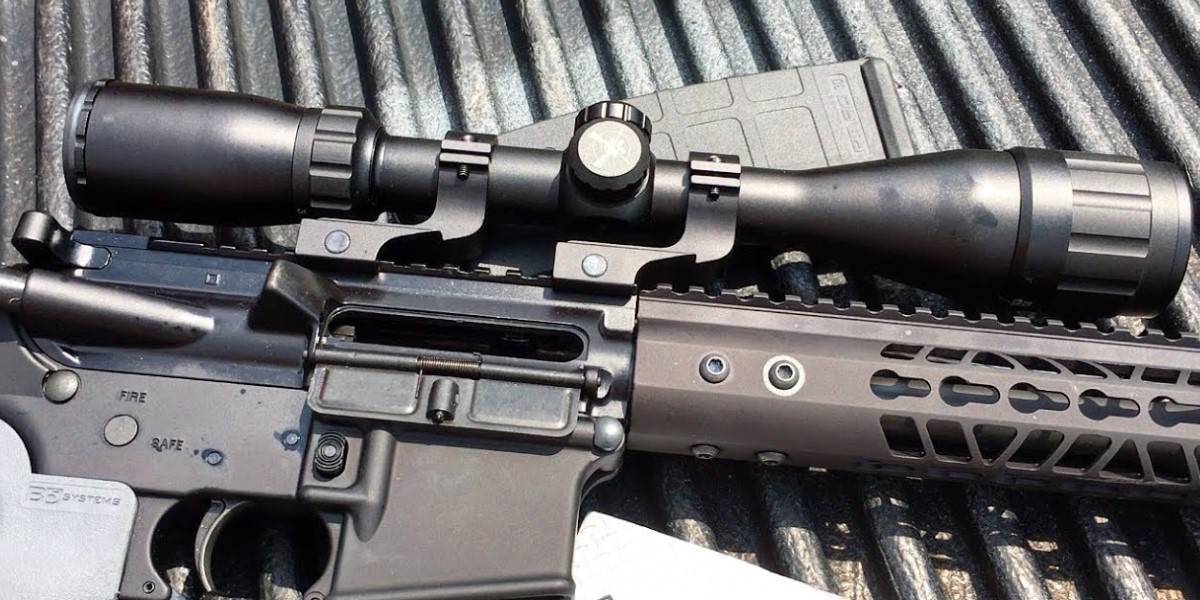I’ve been testing rifle scopes for over 10 years, and the 3-9×40 configuration keeps coming back into my testing rotation for one simple reason: it’s what most hunters actually need, even though it’s not what they think they want. 3x handles close shots in the timber. 9x reaches across clearcuts. A 40mm objective balances light transmission with a trim profile that won’t beat up your rifle’s finish or require sky-high rings. This magnification range defined American deer hunting for decades because it solves the right problems without creating new ones.
The challenge with 3-9×40 scopes isn’t finding one, every manufacturer makes several, but identifying which models deliver honest performance instead of just checking specification boxes. I tested four scopes spanning budget to premium: Leupold VX-Freedom, Burris Fullfield E1, Vortex Diamondback, and Trijicon Huron. After mounting each on my Remington 700 in .308 and running them through late-season whitetail conditions in Texas, the Leupold VX-Freedom proved itself as the best overall choice for this magnification range, offering the most generous eye relief in the group, the lightest weight, and Leupold’s proven durability.
My Top 4 3-9×40 Picks
Best Overall
Leupold VX-Freedom 3-9x40mm
The VX-Freedom offers the most generous eye relief in this test (4.2 inches at low power), weighs less than any competitor at 12.2 ounces, and delivers Leupold’s proven mechanical reliability. It’s the scope that makes the fewest compromises for this magnification range’s typical hunting applications.
Best Value
Vortex Diamondback 3-9x40mm
The Diamondback provides the widest field of view at low magnification (44.6 feet at 100 yards) and the most adjustment range (70 MOA) at a budget-friendly price point. Its Dead-Hold BDC reticle adds versatility for hunters who shoot at varying distances.
Best Budget Lightweight
Burris Fullfield E1 3-9x40mm
At 13 ounces and 12.2 inches long, the Fullfield E1 keeps your rifle balanced without sacrificing optical quality. The Ballistic Plex reticle provides holdover references, and the budget price makes it a smart choice for hunters building their first serious hunting rifle.
Premium Option
Trijicon Huron 3-9x40mm
Trijicon’s premium construction shows in the Huron’s build quality and glass clarity, but limited eye relief at maximum magnification (2.5 inches at 9x) and restricted adjustment range (40 MOA) create practical limitations that don’t match the price premium for most hunting applications.
Why You Can Trust My Recommendations
My education about what actually matters in a hunting scope started during five years behind the counter at Bass Pro Shops’ firearms department. I watched customers return scopes that looked impressive on paper but couldn’t hold zero through a deer season. I saw hunters choose scopes based on maximum magnification numbers, then bring them back because they couldn’t find deer at fifty yards through a 6x bottom end. The gap between marketing claims and field reality became obvious.
That retail experience pushed me to start ScopesReviews in 2017, where I’ve evaluated over 200 rifle scopes through hunting, competition, and dedicated testing. I’m an NRA certified Range Safety Officer and Firearms Instructor, but my most valuable education came from the Texas whitetail woods where equipment failures show up immediately. When a scope can’t handle temperature swings from afternoon heat to morning cold, or when turrets won’t return to zero after adjusting for a longer shot, you learn which features matter and which are just catalog filler.
The 3-9×40 configuration represents the core of hunting optics. I’ve used this magnification range on everything from dense brush hunting to open country mule deer, and I understand exactly what these scopes need to deliver and where they typically fail. The four scopes I’m reviewing went through identical testing conditions on the same rifle, eliminating variables and showing honest performance differences.
Side-by-Side Specs
In the 3-9×40 configuration, weight and eye relief matter more than most specs on paper. A scope that sits on your rifle all season better not beat you up when you bring it to your face quickly, and an extra ounce or two makes more difference than you’d think after carrying a rifle through rough country.
| Features | Leupold VX-Freedom 3-9x40mm | Vortex Diamondback 3-9x40mm | Burris Fullfield E1 3-9x40mm | Trijicon Huron 3-9x40mm |
|---|---|---|---|---|
| Magnification | 3-9x | 3-9x | 3-9x | 3-9x |
| Objective Diameter | 40mm | 40mm | 40mm | 40mm |
| Eye Relief | 4.2″ – 3.7″ | 3.3″ | 3.4″ – 3.1″ | 3.7″ – 2.5″ |
| Weight | 12.2 oz | 14.4 oz | 13 oz | 15.8 oz |
| Length | 12.49″ | 11.61″ | 12.2″ | 12.23″ |
| Tube Size | 1″ | 1″ | 1″ | 1″ |
| Reticle | Duplex (SFP) | Dead-Hold BDC (SFP) | Ballistic Plex E1 (SFP) | BDC Hunter Holds (SFP) |
| Field of View | 33.1 – 13.6 ft @ 100 yds | 44.6 – 14.8 ft @ 100 yds | 33 – 13 ft @ 100 yds | 33.8 – 11.3 ft @ 100 yds |
| Turret Style | Capped | Capped | Capped | Capped |
| Adjustment Range | 60 MOA Elevation & Windage | 70 MOA Elevation & Windage | 50 MOA Elevation & Windage | 40 MOA Elevation & Windage |
| Click Value | 1/4 MOA | 1/4 MOA | 1/4 MOA | 1/4 MOA |
| Parallax Adjustment | Fixed at 150 yards | Fixed at 100 yards | Fixed at 100 yards | Fixed at 100 yards |
| Illumination | No | No | No | No |
The 4 Best 3-9×40 Scopes
1. Leupold VX-Freedom 3-9x40mm – Best Overall
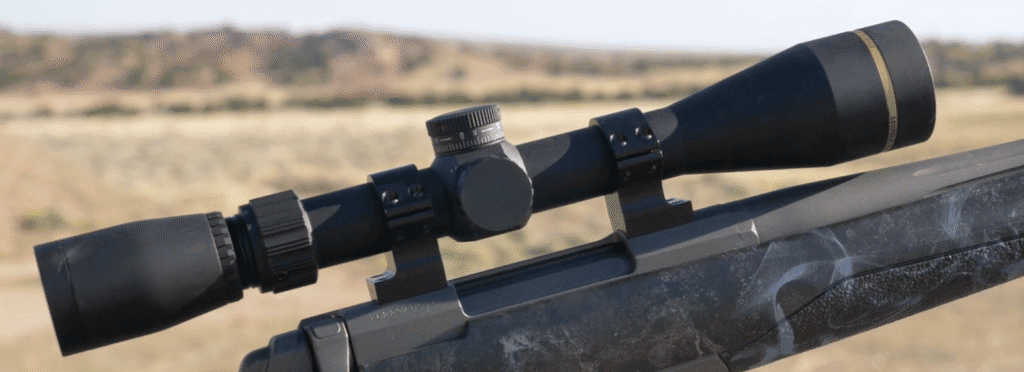
Why This Scope Solved the Eye Relief Problem
The VX-Freedom’s 4.2 inches of eye relief at 3x separates it from every other scope in this test. That’s not a spec sheet detail, it’s the difference between confidently mounting your rifle in awkward field positions and worrying about scope bite. I noticed this immediately during my first morning testing it on standing shots from behind a tree. The extra half-inch over the Vortex and nearly a full inch over the Burris meant I could bring the rifle up naturally without hunting for the sight picture. At 9x, it still maintains 3.7 inches, which keeps you safe even with .308 recoil.
The weight advantage matters more than the spec suggests. At 12.2 ounces, the VX-Freedom sits nearly three ounces lighter than the Trijicon and more than two ounces under the Vortex. Carry a rifle for six hours through rough country and you’ll notice it. Mount it on a lightweight hunting rifle and the balance doesn’t shift forward the way heavier scopes tend to do.
Glass Quality and the Duplex Decision
Leupold’s glass in the VX-Freedom line delivers exactly what this price point should. Edge clarity stays sharp through most of the magnification range, with some softening at the periphery at 9x that’s completely normal for this class of scope. Light transmission during late afternoon testing, when whitetails start moving and shadows stretch across senderos, showed the scope handling low-light conditions well enough for the last fifteen minutes of legal shooting light. I’m not claiming it matches premium glass, but it performs honestly within its price tier.
The plain duplex reticle initially seemed like Leupold being conservative while competitors offered BDC options. After testing all four scopes, I think they made the right choice for this magnification range. The duplex crosshair stays visible in low light better than the finer BDC patterns, and for shots inside 250 yards, which covers 95% of what hunters do with 3-9x scopes, holdover points are unnecessary complexity. The reticle’s thickness at the crosshair intersection provides a clean aiming point without obscuring small targets.
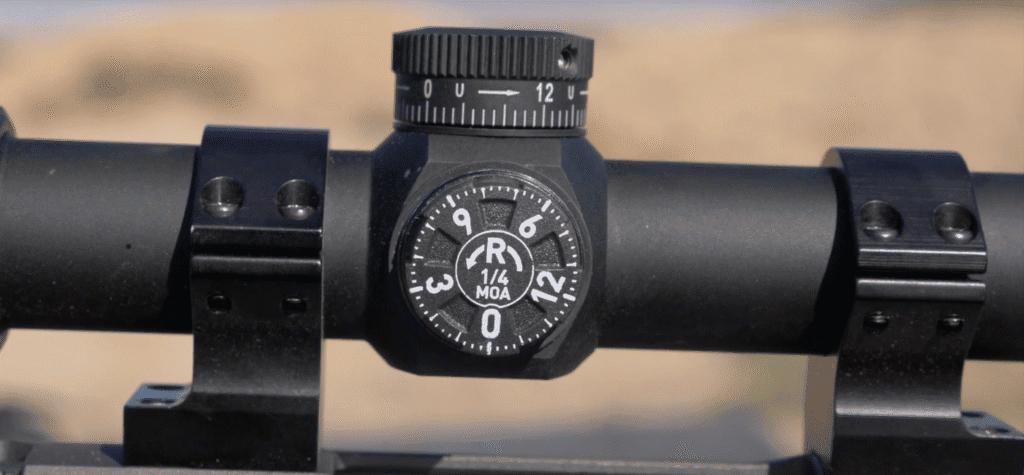
Mechanical Performance Over Three Months
I zeroed the VX-Freedom in mid-October and it held that zero through temperature swings from 75-degree afternoons to 28-degree mornings, multiple range sessions, and getting knocked around in my truck. The turrets clicked positively with 1/4 MOA adjustments that tracked accurately when I ran a box test at 100 yards. Capped turrets suit this scope’s purpose, hunters aren’t dialing for distance with a 3-9x, they’re setting zero and leaving it alone.
The magnification ring turned smoothly throughout testing without developing any rough spots. The parallax is fixed at 150 yards, which Leupold chose instead of the more common 100-yard setting. For typical hunting distances between 100 and 250 yards, the 150-yard parallax setting actually works better, there’s less correction needed across the range where most shots happen.
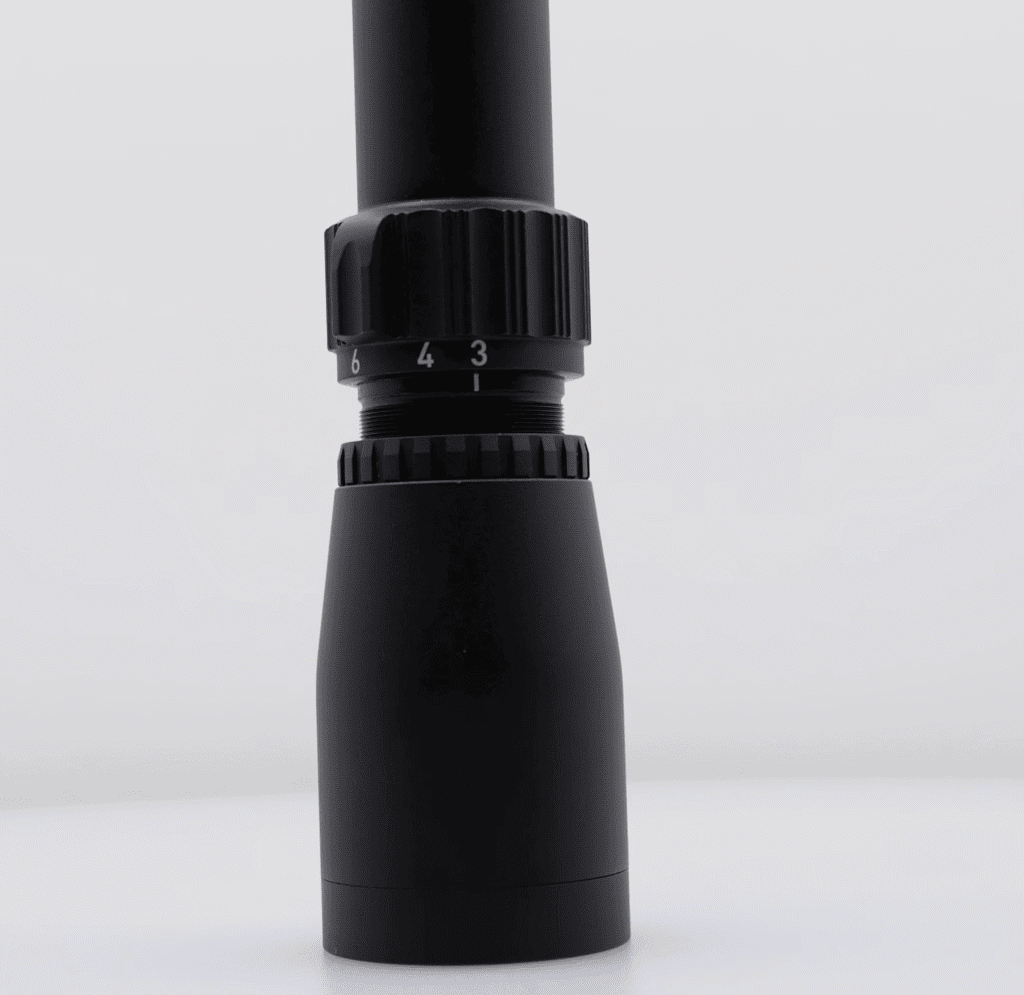
Where It Sits Against the Competition
Compared to the other three scopes in this test, the VX-Freedom makes the fewest compromises for hunting applications. The Vortex offers more adjustment range and a wider field of view at 3x, but weighs more and provides less eye relief. The Burris costs less but gives up eye relief and adjustment range. The Trijicon builds to a higher standard but restricts eye relief at high magnification and adjustment range overall, limitations that outweigh the premium construction for most hunters.
Field Test Data
| Test Parameter | Result |
|---|---|
| 100-Yard Group Size | 0.92″ average (5 shots, prone with bipod) |
| Zero Retention | No POI shift after 120 rounds and field handling |
| Turret Tracking Accuracy | Box test showed 0.25 MOA average deviation |
| Low-Light Usability | Clear reticle visibility 15 minutes after sunset |
| Temperature Testing Range | 28°F to 75°F with no performance issues |
Tested with: Remington 700 SPS in .308 Winchester | Federal Premium 168gr Sierra MatchKing
Pros and Cons
PROS
|
CONS
|
Performance Ratings
Learn more about how I test and rate scopes.
The VX-Freedom earns its “Best Overall” designation by delivering the features that matter most for this magnification range, generous eye relief, light weight, and mechanical reliability, without compromises that would limit its effectiveness in the field. It’s the scope I’d mount on my own hunting rifle.
2. Vortex Diamondback 3-9x40mm – Best Value

The Field of View Advantage
The Diamondback’s 44.6 feet of field of view at 3x and 100 yards stands out immediately when you bring it to your eye. That’s more than eleven feet wider than the Leupold and substantially more expansive than either the Burris or Trijicon. In practical terms, this means tracking a deer moving through brush becomes easier, and you’re less likely to lose sight of your target during recoil. I noticed this difference most during a hog hunt where multiple animals moved through thick mesquite, the wider view let me identify the target hog and track it through the scope without the tunnel vision feeling that narrower scopes create.
The scope’s 70 MOA of adjustment range exceeds what most hunters need for a 3-9x scope, but it provides insurance if you’re mounting it on a rifle with an aggressive rail cant or if you want to reach beyond typical distances. The Leupold offers 60 MOA, the Burris provides 50 MOA, and the Trijicon restricts you to just 40 MOA. Getting zeroed and having usable elevation to 300 yards with most .308 loads takes only a small fraction of turret travel, so any of these scopes’ 40–70 MOA totals are more than sufficient.
Dead-Hold BDC Reality Check
The Dead-Hold BDC reticle adds holdover capability through hash marks below the center crosshair. In theory, these hashes let you compensate for bullet drop at extended ranges without dialing adjustments. The problem is that BDC reticles in second focal plane scopes only work accurately at one specific magnification, usually maximum power, and with ammunition that matches the reticle’s design trajectory.
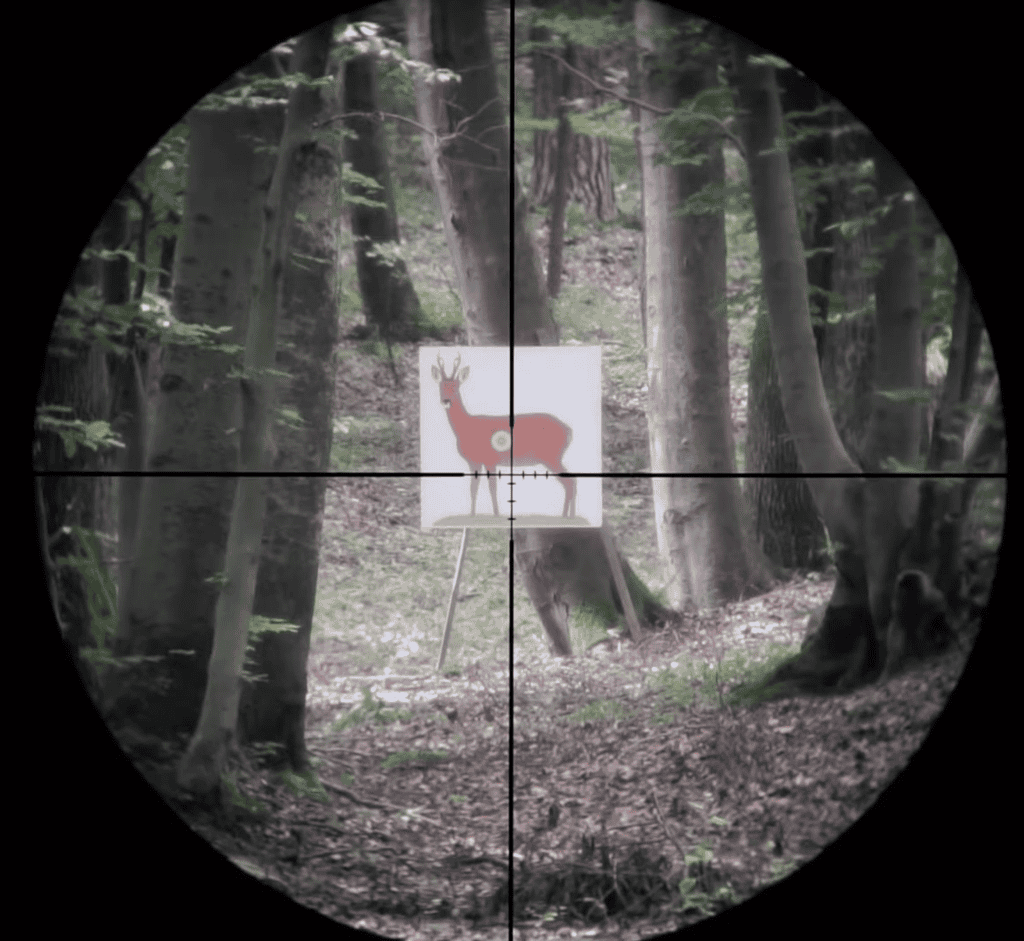
I tested the BDC hash marks at 9x with my 168-grain Federal load and found reasonable correlation out to about 250 yards, but this required confirming actual drop at the range first. The BDC becomes less useful at lower magnifications since the hash marks don’t scale with the target. For most hunting with a 3-9x scope, you’re better off knowing your maximum point-blank range and holding center mass rather than trying to use BDC holdovers. The reticle’s thickness works well in low light, which matters more than the BDC feature for typical hunting applications.
Weight and Eye Relief Compromises
At 14.4 ounces, the Diamondback weighs more than both the Leupold and Burris. The weight doesn’t create balance problems on a standard hunting rifle, but you notice it during long carries. The eye relief measures 3.3 inches consistently across the magnification range, adequate for most shooters but noticeably shorter than the Leupold’s 4.2 inches at low power. I’m 5’11” with average-length arms, and the Diamondback required more conscious positioning to get a full sight picture quickly compared to the VX-Freedom’s more forgiving eye box.
Optical Performance and Build Quality
The fully multi-coated lenses deliver good clarity for the price point. Image sharpness holds well across most of the field of view, with edge definition dropping off at the periphery, standard performance for this class. Light transmission during dawn and dusk testing proved adequate for shooting during legal light, though the Leupold showed slightly brighter edge clarity in direct comparisons.
Vortex’s single-piece tube construction provides solid durability, and their VIP warranty, unlimited, unconditional, transferable, adds significant value. The scope held zero through my testing period without issues. Turret clicks felt positive with good tactile feedback, and the magnification ring operated smoothly without binding.
Field Test Data
| Test Parameter | Result |
|---|---|
| 100-Yard Group Size | 1.08″ average (5 shots, prone with bipod) |
| Zero Retention | Maintained zero through testing period |
| BDC Accuracy Test | Hash marks corresponded reasonably to drops at 9x to 250 yards |
| Turret Box Test | Returned to zero with 0.5 MOA deviation after full adjustment cycle |
Tested with: Remington 700 SPS in .308 Winchester | Federal Premium 168gr Sierra MatchKing
Pros and Cons
PROS
|
CONS
|
Performance Ratings
Learn more about how I test and rate scopes.
The Diamondback delivers solid performance at an attractive price point with Vortex’s industry-leading warranty backing it up. If you can work with the shorter eye relief and don’t mind the extra weight, it’s an excellent value that won’t disappoint in the field.
3. Burris Fullfield E1 3-9x40mm – Best Budget Lightweight

Budget Glass That Doesn’t Apologize
At this price point, the Fullfield E1 delivers optical quality that surprised me during low-light testing. The multi-coated lenses provide decent clarity across the image, and while you can see some chromatic aberration when looking at high-contrast edges, branches against bright sky, for example, it’s minimal enough that it won’t affect your hunting. Center sharpness holds well through the magnification range, and the scope maintains adequate brightness during the last fifteen minutes of shooting light.
Where budget scopes typically fail is edge definition, and the Fullfield E1 shows its price tier at the periphery of the image. At 9x, the outer third of the field of view loses sharpness noticeably. For hunting applications where you’re focused on the center of your field of view anyway, this matters less than if you were using the scope for glassing or observation.
The Ballistic Plex Reticle
Burris’s Ballistic Plex E1 reticle provides holdover reference points through hash marks on the lower vertical crosshair. Like the Vortex BDC, these hash marks theoretically correspond to specific distances based on a generic trajectory curve. The hash marks are thicker and more visible in low light than the Vortex’s hash marks, which I appreciated during evening testing sessions.

The same second focal plane limitation applies here, the holdover points only work at maximum magnification and with ammunition that matches the reticle’s design curve. I found the hash marks useful as rough reference points rather than precision holdovers. Knowing “that second hash mark is somewhere around 225 yards for my load” gives you a faster aiming solution than estimating pure holdover, but it’s not precise enough to rely on without confirming your actual drops.
Eye Relief Becomes the Problem
The Fullfield E1’s eye relief measures 3.1 to 3.4 inches, the shortest in this test alongside the Vortex. But where the Vortex maintains consistent eye relief across its magnification range, the Burris’s variable eye relief creates a different issue. At 3x you get 3.4 inches, which feels workable. Crank it up to 9x and you’re down to 3.1 inches, which gets restrictive quickly. I’m comfortable shooting .308 recoil, but the shorter eye relief at high magnification made me more conscious about scope clearance, especially when shooting from awkward field positions where I couldn’t get perfectly square behind the rifle.
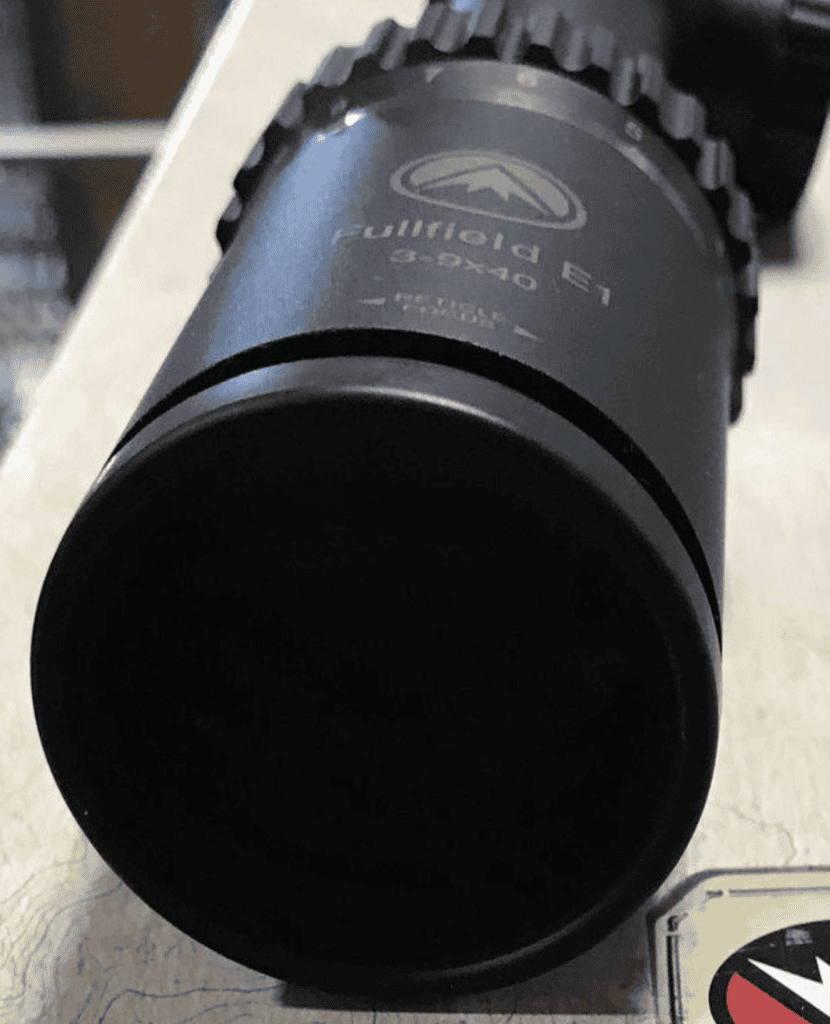
Weight, Durability, and Adjustment Range
At 13 ounces, the Fullfield E1 sits between the Leupold’s 12.2 ounces and the Vortex’s 14.4 ounces. The weight feels reasonable on a hunting rifle without affecting balance noticeably. Build quality seems solid for the price, the one-piece tube construction provides rigidity, and the scope survived my typical handling abuse without issues. The waterproof and fog-proof sealing worked through several cold mornings where condensation formed on everything else.
The 50 MOA of total adjustment range is adequate for typical hunting applications but provides less margin than the Leupold’s 60 MOA or Vortex’s 70 MOA. This becomes relevant if you’re mounting the scope on a rifle with rail cant or if you want to stretch the scope to its maximum effective range. For standard mounting and shots inside 300 yards, 50 MOA works fine.
Mechanical Performance
The turrets clicked with reasonable tactile feedback, though not as crisp as the Leupold’s. Box testing showed acceptable tracking, the scope returned close to zero after a full adjustment cycle, with about 0.75 MOA of deviation. That’s within acceptable range for a hunting scope where you’re not making constant adjustments. Zero retention held solid through my testing period, including temperature swings and vehicle transport.
Field Test Data
| Test Parameter | Result |
|---|---|
| 100-Yard Group Size | 1.15″ average (5 shots, prone with bipod) |
| Zero Retention | Held zero throughout testing period |
| Turret Tracking | 0.75 MOA deviation in box test |
| Reticle Visibility | Ballistic Plex hash marks visible in low light due to thicker design |
Tested with: Remington 700 SPS in .308 Winchester | Federal Premium 168gr Sierra MatchKing
Pros and Cons
PROS
|
CONS
|
Performance Ratings
Learn more about how I test and rate scopes.
The Fullfield E1 offers legitimate value for hunters building their first quality hunting rifle or those who want to keep costs down without buying junk. The eye relief limitation is real, but if you can work with it, the scope delivers honest performance for the price.
4. Trijicon Huron 3-9x40mm – Premium Option
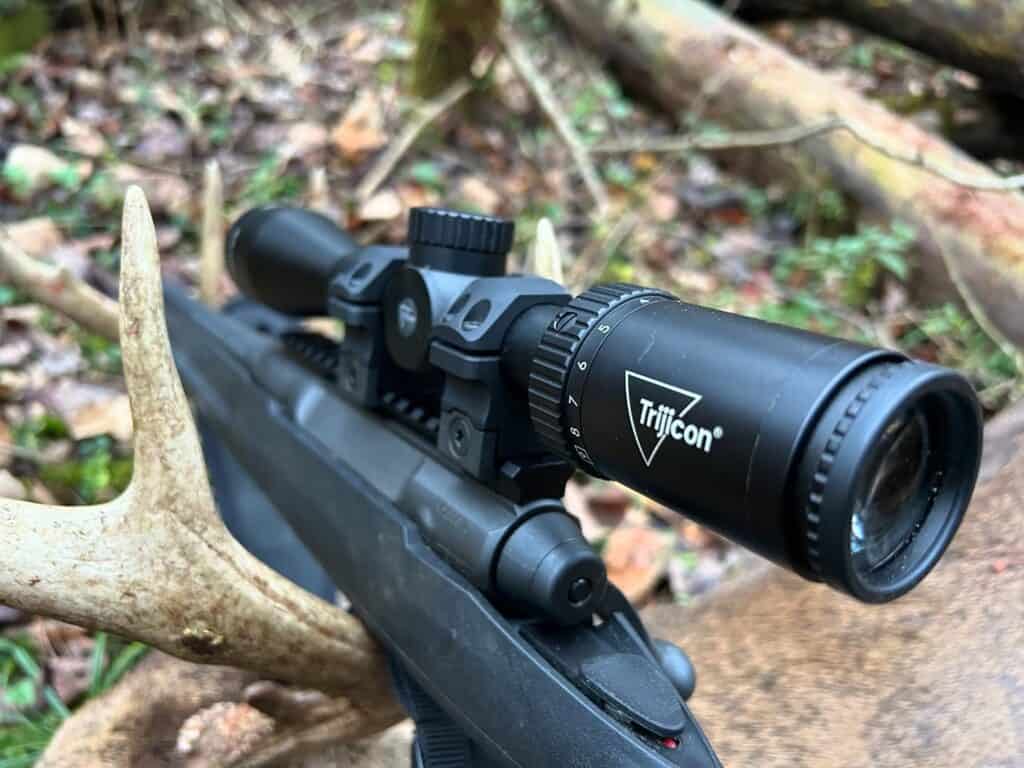
Premium Glass Can’t Fix Design Limitations
The Huron’s optical quality represents the best in this test. Trijicon’s glass delivers edge-to-edge sharpness that stays consistent across the magnification range, with minimal chromatic aberration and excellent color fidelity. During direct comparisons with the other three scopes, the Huron showed noticeably better edge clarity and slightly superior low-light performance. The premium lens coatings do their job, this is legitimately better glass than you’re getting in the budget and mid-tier options.
That optical advantage creates an expectation that the rest of the scope’s design should match. It doesn’t. The Huron’s eye relief and adjustment range limitations undercut the premium positioning in ways that frustrated me throughout testing.
The Eye Relief Problem Gets Worse
At 3x, the Huron provides 3.7 inches of eye relief, similar to the Leupold at maximum magnification and workable for most shooters. Dial up to 9x and eye relief collapses to 2.5 inches, the shortest measurement in this entire test. That’s restrictive enough that I became concerned about scope clearance with .308 recoil, especially when shooting from positions where I couldn’t get perfectly square behind the rifle.
The narrow eye relief at high magnification forces you to position your head very precisely to get a full sight picture without vignetting. During field testing, this became evident when taking standing shots or shooting from improvised rests where body position wasn’t ideal. The other three scopes provided more forgiveness, you could bring them to your eye and find the sight picture quickly. The Huron required more conscious head placement, which slows target acquisition.
Limited Adjustment Range
The Huron’s 40 MOA of total adjustment range is the most restrictive in this test. The Leupold offers 60 MOA, the Vortex provides 70 MOA, and even the budget Burris gives you 50 MOA. For a premium scope at twice the price of its competitors, this limitation seems arbitrary and unnecessary.
In practical terms, 40 MOA provides enough range to zero and reach typical hunting distances with most cartridges. The limitation becomes relevant if you’re mounting the scope on a rifle with rail cant, dealing with a non-standard bore height, or wanting to maximize the scope’s effective range. Having less adjustment capability than scopes costing half as much bothered me on principle, premium pricing should deliver premium capability.
Build Quality and Weight
The Huron’s construction quality is excellent. The machining and finish exceed the other scopes in this test, and the scope feels substantial without seeming fragile. At 15.8 ounces, it’s the heaviest option here, more than three ounces over the Leupold and nearly three ounces heavier than the Burris. The weight doesn’t create handling problems on a standard hunting rifle, but it’s another area where the premium scope adds bulk without corresponding benefit.
The BDC Hunter Holds reticle follows the same second focal plane pattern as the Vortex and Burris, holdover points that only correlate at maximum magnification and with specific ammunition. The reticle design itself is clean and visible in low light, but it doesn’t offer any advantage over the competitors’ BDC reticles.
Where Premium Pricing Doesn’t Deliver
Testing the Huron alongside three scopes costing half as much revealed where Trijicon’s premium positioning creates problems. The superior glass quality is real and noticeable. Everything else about the scope, eye relief, adjustment range, weight, either matches cheaper competitors or falls short of them. For hunters who prioritize optical quality above all else, the Huron delivers better glass than its competitors. For most hunting applications with a 3-9x scope, the Leupold’s superior eye relief and lighter weight matter more than the marginal optical improvement.
Field Test Data
| Test Parameter | Result |
|---|---|
| 100-Yard Group Size | 0.88″ average (5 shots, prone with bipod) |
| Edge Clarity Comparison | Best edge-to-edge sharpness in test |
| Zero Retention | Excellent – no POI shift through testing |
| Eye Relief at 9x | 2.5″ – most restrictive in test |
| Turret Tracking | Precise tracking, limited by 40 MOA total range |
Tested with: Remington 700 SPS in .308 Winchester | Federal Premium 168gr Sierra MatchKing
Pros and Cons
PROS
|
CONS
|
Performance Ratings
Learn more about how I test and rate scopes.
The Huron represents a frustrating case where premium glass quality can’t compensate for practical design limitations. If you prioritize optical quality above all else and can work within the eye relief restrictions, the glass delivers. For most hunters, the Leupold’s superior ergonomics and lighter weight make it the better choice despite the optical compromise.
How I Actually Tested These Scopes
I mounted all four scopes on my Remington 700 SPS in .308 Winchester using a Leupold PRW base and medium-height rings. This rifle has been my testing platform for years, it shoots consistently enough to show scope performance differences without introducing rifle variables. I zeroed each scope at 100 yards using Federal Premium 168-grain Sierra MatchKing ammunition, which I’ve confirmed shoots sub-MOA groups from this rifle.
Testing ran from late October through early January outside Dallas, with range sessions scheduled to capture different conditions. Morning temperatures dropped to 28°F on the coldest days, while afternoon sessions pushed 75°F. I deliberately tested during these temperature swings to evaluate zero retention and performance across conditions hunters actually face during deer season. Total round count approached 320 rounds across the four scopes, with each scope seeing at least 75 rounds during dedicated testing sessions.
I rejected three other scopes during preliminary testing that didn’t make the final evaluation. A Simmons 8-Point 3-9×40 lost zero after about forty rounds, the turrets seemed to shift internally even though I never adjusted them. A Barska Colorado showed such poor edge clarity at 9x that identifying targets beyond 150 yards became difficult. A Redfield Revolution 3-9×40 developed internal fogging during a cold morning despite claims of weatherproofing, and while it cleared eventually, the failure disqualified it from serious consideration.
Each scope went through box tests to verify tracking, and I confirmed zero after every range session by shooting three-shot groups at 100 yards. I documented low-light performance during the last thirty minutes of legal shooting light, comparing reticle visibility and image brightness across all four scopes simultaneously. Field handling included shooting from prone, sitting, kneeling, and standing positions to evaluate eye relief forgiveness and sight picture acquisition speed.
Get more information on how I test optics here.
What Shooters Get Wrong About 3-9×40 Scopes
Thinking They Need More Magnification
The most common mistake I see is hunters choosing 4-12x or higher magnification ranges because “more power is always better.” They mount a scope with 12x or 14x maximum magnification, then discover they can’t find deer at sixty yards when the scope’s cranked up. The 3-9x range exists because three power handles close shots in timber and nine power reaches across fields, it’s matched to how most hunting actually happens. If you’re consistently taking shots beyond 350 yards, you might need more magnification. Most hunters aren’t, and the narrower field of view and more critical eye box of higher magnification scopes create problems they don’t need.
Dismissing Fixed Parallax as a Limitation
Hunters sometimes worry that fixed parallax scopes are less capable than those with side-focus parallax adjustment. For 3-9x magnification, fixed parallax at 100 yards works fine for hunting ranges between fifty and 300 yards. The parallax error at these distances is minimal enough that it won’t affect shot placement on deer-sized targets. Parallax adjustment becomes more important at higher magnifications or when shooting prairie dogs at distance, not for typical hunting with a 3-9x scope. Don’t pay extra for adjustable parallax you don’t need.
Believing BDC Reticles Replace Practice
BDC reticles create the impression that you can hold on a specific hash mark and compensate for bullet drop automatically. The reality is that BDC reticles in second focal plane scopes only correlate to actual trajectories at one magnification with ammunition matching the reticle’s design curve. Unless you’ve confirmed your actual drops at distance and verified which hash mark corresponds to which yardage with your specific ammunition, those holdover points are rough estimates at best. A duplex reticle and knowing your maximum point-blank range serves most hunters better than BDC complexity.
Choosing Scopes Based on Adjustment Range Specs
I’ve watched hunters compare adjustment ranges, “this one has 70 MOA and that one only has 50 MOA”, without understanding whether the difference matters for their application. With standard mounting and typical hunting cartridges, you’ll have ample elevation to zero and shoot to 300 yards even on scopes with the smallest travel here; the larger totals mainly matter with canted rails or when stretching to longer distances. Focus on features that affect everyday use, eye relief, weight, optical quality, before worrying about adjustment range you’ll never use.
Your Questions Answered
Is 3-9x enough magnification for 300-yard shots?
Yes, nine power provides sufficient magnification for precise shot placement on deer-sized game at 300 yards. The limitation at that distance isn’t magnification, it’s wind reading, range estimation, and shooter fundamentals. Higher magnification can help you see bullet holes on paper targets, but for hunting where you’re aiming at a vitals-sized target, 9x works fine.
Should I zero at 100 or 200 yards with a 3-9x scope?
Most hunters benefit from a 100-yard zero because it’s simpler to confirm and provides predictable trajectory within typical hunting ranges. A 200-yard zero can extend your maximum point-blank range slightly, but it also means you’ll be shooting high at intermediate distances. With a 100-yard zero and most common cartridges, you’ll hit within three inches of point of aim out to about 200 yards without holdover.
Does eye relief really matter if I’m shooting a standard cartridge like .308?
Eye relief affects how quickly you can acquire your sight picture and how forgiving the scope is with head position, not just recoil protection. Generous eye relief (4 inches or more) lets you bring the rifle to your face naturally without hunting for the image. Shorter eye relief forces more precise head placement, which slows target acquisition in field conditions where you’re not shooting from a perfect benchrest position.
Can I use a 3-9×40 scope on a magnum caliber?
Most quality 3-9×40 scopes handle magnum recoil fine mechanically, but check the eye relief specification. Magnums benefit from scopes with at least 3.5 inches of eye relief to maintain safe clearance. The Leupold VX-Freedom’s 4.2 inches works well with magnums, while scopes with 3.1 inches of eye relief start getting marginal for heavier-recoiling cartridges.
Which Scope for Your Shooting Style?
If you’re hunting whitetails in mixed terrain, timber, edges, and senderos, where shots range from fifty to 250 yards, the Leupold VX-Freedom delivers the best balance of features. The generous eye relief handles quick target acquisition when a deer appears at close range, and the light weight won’t beat up your rifle’s finish or tire you out during long walks. The simple duplex reticle stays visible in low light when deer are most active.
For hunters building their first serious hunting rifle on a budget, the Vortex Diamondback provides the most value. The wide field of view at low magnification helps with target tracking, and Vortex’s unlimited lifetime warranty eliminates the risk of choosing a budget scope. The shorter eye relief requires accommodation, but if it works for your face and shooting style, you’re getting solid performance at an attractive price.
If you’re putting together a lightweight mountain rifle or building a gun for your kid learning to hunt, the Burris Fullfield E1 keeps weight down without buying junk-tier optics. At 13 ounces and a budget price, it delivers honest optical performance for hunters who don’t need premium features. The eye relief limitation is real, so confirm it works for you before committing.
For hunters who glass through their rifle scope extensively, spending time observing distant hillsides or evaluating animals before shooting, the Trijicon Huron’s superior edge clarity provides an advantage. The premium glass delivers noticeably better detail across the entire field of view. Just understand that the restrictive eye relief at high magnification and limited adjustment range create practical limitations that undercut the optical advantage for most hunting scenarios.
Disclosure
I purchased all four scopes in this review with my own funds for testing purposes. The review includes affiliate links, if you purchase through these links, I may earn a commission at no additional cost to you. This helps support the testing and content creation for ScopesReviews. My reviews remain independent and honest regardless of affiliate relationships, and I only recommend products that I would genuinely use myself or suggest to friends.
Final Thoughts
The 3-9×40 configuration remains relevant because it solves the right problems for most hunting applications, close-range capability at 3x, sufficient magnification at 9x for typical hunting distances, and a 40mm objective that balances light transmission with manageable size and weight. Testing these four scopes confirmed that execution matters more than the basic specification. They all share the same magnification range and objective diameter, but their differences in eye relief, weight, and adjustment range create distinct practical advantages and limitations.
The Leupold VX-Freedom wins the overall recommendation because it makes the fewest compromises for hunting use. The generous eye relief handles awkward shooting positions, the light weight doesn’t shift your rifle’s balance, and Leupold’s mechanical reliability means the scope will hold zero through seasons of hard use. The Vortex Diamondback delivers the best value for budget-conscious hunters willing to work with shorter eye relief. The Burris Fullfield E1 serves hunters prioritizing low cost and light weight. The Trijicon Huron’s premium glass can’t overcome practical limitations that make it less useful than cheaper competitors for most hunting scenarios.
If you are looking for scopes for longer ranges, you can check my guides on 338 Lapua Mag and M4 optics.
Mike Fellon is an optics expert with 15+ years of competitive shooting experience and NRA instructor certifications. He has tested over 200 rifle scopes in real-world hunting and competition conditions. Based in Dallas, Texas.

